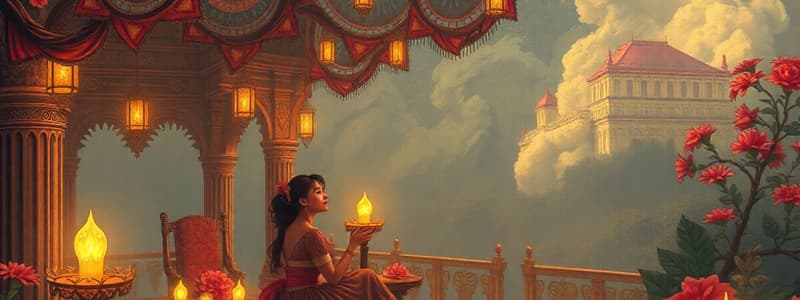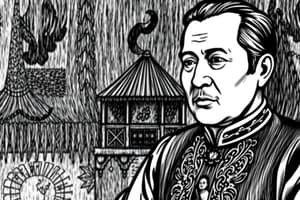Podcast
Questions and Answers
What was the primary method through which values were taught to children during the pre-colonial period in the Philippines?
What was the primary method through which values were taught to children during the pre-colonial period in the Philippines?
- Formal education in schools
- Reading written literature
- Discussing with community leaders
- Telling stories like legends and myths (correct)
Which of the following best describes the impact of colonialism on Philippine literature's oral tradition?
Which of the following best describes the impact of colonialism on Philippine literature's oral tradition?
- It obscured the country's oral past significantly. (correct)
- It encouraged the use of native languages.
- It completely eliminated traditional folklore.
- It enhanced the growth of written literature.
What form of folk literature includes riddles and is known by different names in various Philippine regions?
What form of folk literature includes riddles and is known by different names in various Philippine regions?
- Oral Literature (correct)
- Historical Narratives
- Epic Poetry
- Allegorical Tales
What was the main purpose of the nationalistic pride movement in the Philippines during the 1960s and 1970s?
What was the main purpose of the nationalistic pride movement in the Philippines during the 1960s and 1970s?
What was Alibata in the context of Philippine literature?
What was Alibata in the context of Philippine literature?
What defines the genre of hypertext in literature?
What defines the genre of hypertext in literature?
Which of the following best describes flash fiction?
Which of the following best describes flash fiction?
What is a defining characteristic of chik lit?
What is a defining characteristic of chik lit?
Which literary genre is characterized by a 50% visual narrative?
Which literary genre is characterized by a 50% visual narrative?
What distinguishes sci-fi from other literary genres?
What distinguishes sci-fi from other literary genres?
How is the short story generally characterized?
How is the short story generally characterized?
What is one key feature of electronic literature?
What is one key feature of electronic literature?
Which type of literature typically uses the method of exchanging messages via electronics?
Which type of literature typically uses the method of exchanging messages via electronics?
What defines the setting in a literary work?
What defines the setting in a literary work?
Which literary device primarily appeals to the physical senses through figurative language?
Which literary device primarily appeals to the physical senses through figurative language?
What is the primary purpose of symbolism in literature?
What is the primary purpose of symbolism in literature?
What is the climax in the context of a plot?
What is the climax in the context of a plot?
How does point of view affect a story?
How does point of view affect a story?
What distinguishes figurative language from literal language?
What distinguishes figurative language from literal language?
Which of the following is NOT a function of imagery in poetry?
Which of the following is NOT a function of imagery in poetry?
What is the primary element that a theme conveys in a narrative?
What is the primary element that a theme conveys in a narrative?
What is the primary function of hyperbole in writing?
What is the primary function of hyperbole in writing?
Which phrase best exemplifies understatement?
Which phrase best exemplifies understatement?
What literary device involves the repetition of a phrase at the beginning of successive sentences?
What literary device involves the repetition of a phrase at the beginning of successive sentences?
Which of the following is an example of a rhetorical question?
Which of the following is an example of a rhetorical question?
What distinguishes litotes from other figures of speech?
What distinguishes litotes from other figures of speech?
Which example best illustrates the concept of pun?
Which example best illustrates the concept of pun?
Which term refers specifically to the repetition of a word or phrase at the end of successive sentences?
Which term refers specifically to the repetition of a word or phrase at the end of successive sentences?
In which literary device is the phrase 'not bad' used as an ironic understatement?
In which literary device is the phrase 'not bad' used as an ironic understatement?
What identifies a simile in figurative language?
What identifies a simile in figurative language?
Which statement best describes a metaphor?
Which statement best describes a metaphor?
What does personification involve?
What does personification involve?
Which example exemplifies metonymy?
Which example exemplifies metonymy?
How is synecdoche defined in figurative language?
How is synecdoche defined in figurative language?
Which phrase is an example of onomatopoeia?
Which phrase is an example of onomatopoeia?
Which of the following figures of speech uses direct address?
Which of the following figures of speech uses direct address?
What distinguishes figurative language from literal language?
What distinguishes figurative language from literal language?
Flashcards are hidden until you start studying
Study Notes
Colonial Influence and Filipino Identity
- Colonialists attempted to erase the Philippines' oral literary past, leading to a national movement among writers to reclaim ethnic traditions.
- The rise of nationalism in the 1960s and 1970s fostered a renewed interest in Filipino identity among new generations.
Pre-colonial Period (Early Times – 1564)
- The longest era in Philippine literary history occurred before Spanish colonization, highlighting indigenous literature.
- Ancient Philippine literature captured customs and traditions through folk stories, songs, and narratives.
- Oral literature dominated the period, with parents as the primary educators, imparting values through legends, myths, and folktales.
- Alibata, the original Filipino alphabet, transitioned to the Roman alphabet under Spanish rule.
Forms of Literature
- Oral Literature:
- Riddles (bugtong): Engaging word plays also known as Tigmo (Cebu), Paktakon (Ilongo), and Patotdon (Bicol).
- Includes short stories, folk narratives, and proverbs.
21st Century Literary Genres
- Hypertext: Non-linear electronic literature utilizing hyperlinks for reader interaction and story arrangement.
- SMS: Short Message Service, commonly called text messaging.
- Emails: A method for electronic communication.
- Blogs: Online journals with chronological entries; derived from "web log."
- Flash Fiction: Extremely brief literary works, varying from a word to a thousand words.
- Illustrated Novel: Combines images and text, requiring reader interpretation of visuals for narrative comprehension.
- Sci-fi: Speculative fiction focusing on futuristic elements and imaginative concepts.
- Chic lit: Light-hearted fiction exploring modern womanhood, featuring female protagonists.
Aspects of Short Stories
- Defined by a limited number of characters, concise settings, and a singular central event, ideal for quick reading.
- Essential elements include:
- Character: Involved individuals or animals in the story's action.
- Setting: Geographic and temporal context.
- Plot: The series of events culminating in a climax.
- Point of View: The narrative perspective chosen by the author.
- Theme: The underlying message conveyed to readers.
Literary Devices in Poetry
- Imagery: Use of descriptive language to create vivid mental pictures appealing to the senses.
- Examples: Dark forests, aromas of coffee, sensations of fabric.
- Symbolism: Objects representing deeper meanings beyond their literal sense.
- Figures of Speech: Enrich language through comparisons, evoking imagination beyond surface meanings.
- Comparison Figures:
- Simile: Direct comparisons using "like" or "as."
- Metaphor: Indirect comparisons without linking words.
- Personification: Imparting human traits to non-human entities.
- Apostrophe: Directly addressing absent or inanimate entities.
- Association Figures:
- Metonymy: Substituting a term closely related to the thing meant.
- Synecdoche: Using a part to represent the whole or vice versa.
- Sound Effect Figures:
- Onomatopoeia: Words formed from associated sounds.
- Hyperbole: Exaggeration for emphasis.
- Understatement: Minimizing the significance of an event or object.
- Anaphora: Repetition at the beginning of successive clauses.
- Epistrophe: Repetition at the end of successive clauses.
- Rhetorical Question: Provocative questions that emphasize a point.
- Litotes: Ironic understatements.
- Pun: Playful use of language suggesting dual meanings.
- Comparison Figures:
Studying That Suits You
Use AI to generate personalized quizzes and flashcards to suit your learning preferences.




